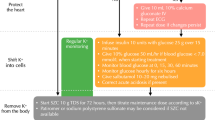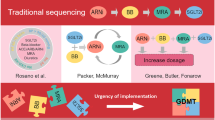Abstract
Background
The prevalence of atrial fibrillation (AF) is high in hemodialysis (HD) patients. It was suggested that oral anticoagulant therapy (OAT), the choice treatment for reducing the thromboembolic risk in AF patients, increases the incidence of both ischemic and hemorrhagic strokes in the HD population. Moreover, the therapy-related bleeding risk is particularly high in these patients. For these reasons there is no agreement on the use of OAT in HD patients with AF. The aim of this study was to evaluate the criteria adopted by nephrologists in prescribing OAT in HD patients with AF.
Methods
All the patients presenting AF (paroxysmal, persistent or permanent) at 31/10/2010 (n = 290) were recruited from 1529 HD patients from ten Italian HD centres. To detect factors related to OAT administration the main clinical features, CHADS2 and HASBLED scores were evaluated in logistic regression models.
Results
The presence of permanent AF (OR = 4.28, p < 0.0001) was the only clinical factor directly associated to OAT administration, while previous bleedings (OR = 0.35, p = 0.004) were inversely related. The CHADS2 score was not associated with OAT prescription (OR = 0.85, p = 0.08), while an inverse relation was found with the hemorrhagic risk score (OR = 0.74, p = 0.03).
Conclusion
A high AF prevalence was observed in our HD population, but less than 50 % of these patients received OAT. Patients with permanent AF were more frequently treated with warfarin, while OAT administration was uncommon in those with previous bleedings. The thromboembolic risk score was not associated with warfarin prescription, while there was an inverse relation with the hemorrhagic risk score.
Similar content being viewed by others
References
Benjamin EJ, Wolf PA, D’Agostino RB, Silbershatz H, Kannel WB, Levy D (1998) Impact of atrial fibrillation on the risk of death: the Framingham Heart Study. Circulation 98:946–952
Lévy S, Maarek M, Coumel P et al (1999) Characterization of different subsets of atrial fibrillation in general practice in France. Circulation 99:3028–3035
Lip GY (2011) Stroke in atrial fibrillation: epidemiology and thromboprophylaxis. J Thromb Haemost 9:344–351
Camm AJ, Lip GYH, De Caterina R et al (2012) An update of the 2010 ESC Guidelines for the management of atrial fibrillation developed with the special contribution of the European Heart Rhythm Association. Eur Heart J 33(21):2719–2747
ACC/AHA/ESC 2006 Guidelines for the Management of Patients With Atrial Fibrillation—Executive Summary (2001) A Report of the American College of Cardiology/American Heart Association Task Force on Practice Guidelines and the European Society of Cardiology Committee for Practice Guidelines (Writing Committee to Revise the Guidelines for the Management of Patients with Atrial Fibrillation). Circulation 2006(114):700–752
Camm AJ, Kirchhof P, Lip GY et al (2010) ESC Committee for Practice Guidelines, Guidelines for the management of atrial fibrillation: the Task Force for the Management of Atrial Fibrillation of the European Society of Cardiology (ESC). Europace 12:1360–1420
Vazquez E, Sanchez-Perales C, Borrego F et al (2000) Influence of atrial fibrillation on the morbido-mortality of patients on hemodialysis. Am Heart J 140:886–890
Genovesi S, Pogliani D, Faini A et al (2005) Prevalence of atrial fibrillation and associated factors in a population of long-term hemodialysis patients. Am J Kidney Dis 46:897–902
Winkelmayer WC, Patrick AR, Liu J, Brookhart MA, Setoguchi S (2011) The increasing prevalence of atrial fibrillation among hemodialysis patients. J Am Soc Nephrol 22:349–357
Seliger SL, Gillen DL, Longstreth WT, Kestenbaum B, Stehman-Breen CO (2003) Elevated risk of stroke among patients with end-stage renal disease. Kidney Int 64:603–609
Genovesi S, Vincenti A, Rossi E et al (2008) Atrial fibrillation and morbidity and mortality in a cohort of long -term hemodialysis patients. Am J Kidney Dis 2:255–262
Sanchez-Perales C, Vazquez E, Garcia-Cortes MJ et al (2010) Ischaemic stroke in incident dialysis patients. Nephrol Dial Transplant 25:3343–3348
Olesen JB, Lip GYH, Kamper AL et al (2012) Stroke and bleeding in atrial fibrillation with chronic kidney disease. N Engl J Med 367:625–635
Boccardo P, Remuzzi G, Galbusera M (2004) Platelet dysfunction in renal failure. Semin Thromb Hemost 30:579–589
Elliott MJ, Zimmerman D, Holden RM (2007) Warfarin anticoagulation in hemodialysis patient: a systemic review of bleeding rates. Am J Kidney Dis 50:433–440
Chan KE, Lazarus M, Thadhani R, Hakim RM (2009) Warfarin use associates with increased risk for stroke in hemodialysis patients with atrial fibrillation. J Am Soc Nephrol 20:2223–2233
Wizemann V, Tong L, Statayathum S et al (2010) Atrial fibrillation in hemodialysis patients: clinical features and associations with anticoagulant therapy. Kidney Int 77:1098–1106
Winkelmayer WC, Liu J, Setoguchi S, Choudhry NK (2011) Effectiveness and safety of Warfarin initiation in older hemodialysis patients with incident atrial fibrillation. Clin J Am Soc Nephrol 6:2662–2668
Danziger J (2008) Vitamin K-dependent proteins, warfarin, and vascular calcification. Clin J Am Soc Nephrol. 3:1504–1510
Di Pasquale G, Mathieu G, Maggioni AP et al (2012) Current presentation and management of 7148 patients with atrial fibrillation in cardiology and internal medicine hospital centers: the ATAAF study. Int J Cardiol (in press)
Turakhia MP, Hoang DD, Xu X et al (2013) Differences and trends in stroke prevention anticoagulation in primary care vs. cardiology specialty management of new atrial fibrillation: the retrospective Evaluation and assessment of therapies in AF (TREAT-AF) study. Am Heart J 165:93–101
Go AS, Hylek EM, Borowsky LH, Phillips KA, Selby JV, Singer DE (1999) Warfarin use among ambulatory patients with nonvalvular atrial fibrillation: the anticoagulation and risk factors in atrial fibrillation (ATRIA) study. Ann Intern Med 131:927–934
Monte S, Macchia A, Pellegrini F et al (2006) Antithrombotic treatment is strongly underused despite reducing overall mortality among high-risk elderly patients hospitalized with atrial fibrillation. Eur Heart J 27:2217–2223
Zimetbaum PJ, Thosani A, Yu HT et al (2010) Are atrial fibrillation patients receiving warfarin in accordance with stroke risk? Am J Med 123:446–453
Nieuwlaat R, Capucci A, Lip GY et al (2006) Antithrombotic treatment in real-life atrial fibrillation patients: a report from the Euro Heart Survey on atrial fibrillation. Eur Heart J 27:3018–3026
Winkelmayer WC, Liu J, Patrick AR, Setoguchi S, Choudhry NK (2012) Prevalence of atrial fibrillation and warfarin use in older patients receiving hemodialysis. J Nephrol 25:341–353
Waldo AL, Becker RC, Tapson VF, Colgan KJ (2005) Hospitalized patients with atrial fibrillation and a high risk of stroke are not being provided with adequate anticoagulation. J Am Coll Cardiol 46:1729–1736
Flaker GC, Belew K, Beckman K et al (2005) AFFIRM investigators: asymptomatic atrial fibrillation: demographic features and prognostic information from the atrial fibrillation follow-up investigation of rhythm management (AFFIRM) study. Am Heart J 149:657–663
Friberg L, Hammar N, Rosenqvist M (2010) Stroke in paroxysmal atrial fibrillation: report from the Stockholm cohort of atrial fibrillation. Eur Heart J 31:967–975
Chou CY, Kuo HL, Wang SM et al (2010) Outcome of atrial fibrillation among patients with end-stage renal disease. Nephrol Dial Transplant 25:1225–1230
Conflict of interest
There are no conflicts of interest.
Author information
Authors and Affiliations
Corresponding author
Rights and permissions
About this article
Cite this article
Genovesi, S., Rossi, E., Pogliani, D. et al. The nephrologist’s anticoagulation treatment patterns/regimens in chronic hemodialysis patients with atrial fibrillation. J Nephrol 27, 187–192 (2014). https://doi.org/10.1007/s40620-013-0030-3
Received:
Accepted:
Published:
Issue Date:
DOI: https://doi.org/10.1007/s40620-013-0030-3




